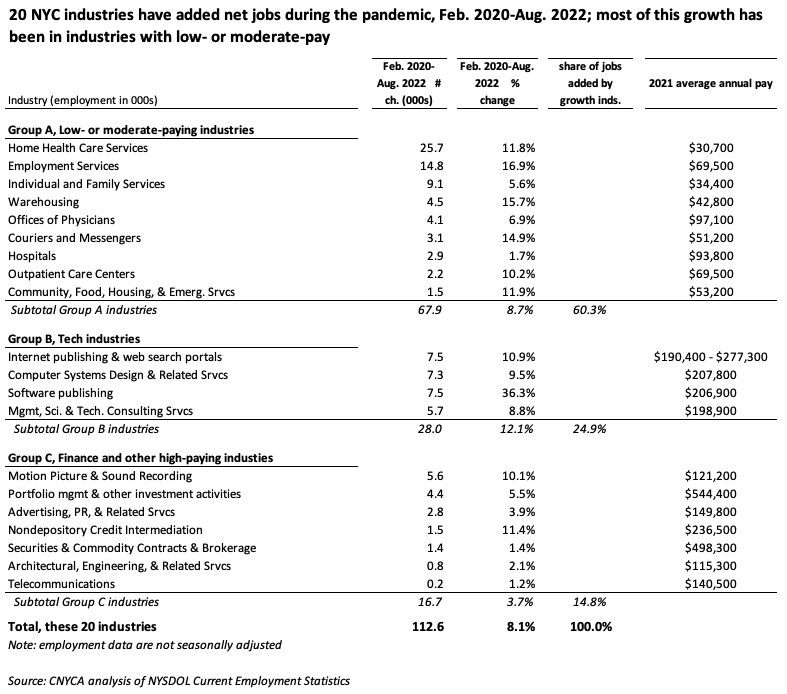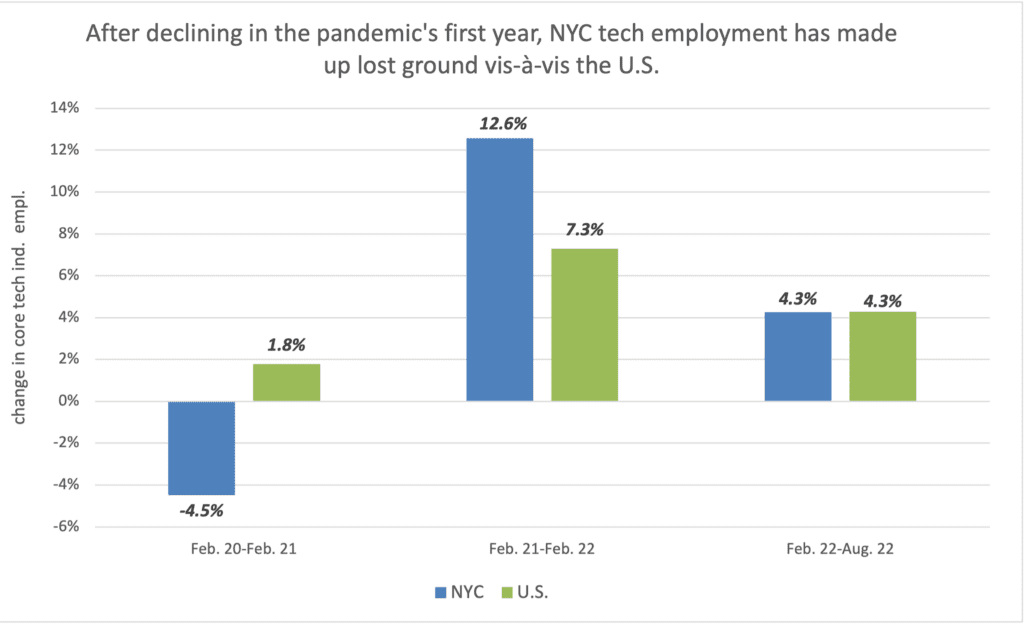Twenty industries have added 113,000 jobs since February of 2022, but there are also concerns about job quality; gig jobs are back to pre-pandemic levels
COVID-19 Economic Update is part of a regular biweekly Covid-19 Economic Update series. This week’s update was prepared by James Parrott, Director of Economic and Fiscal Policies at the Center for New York City Affairs at The New School. Read past installments here.
Despite the facts that New York City lags the nation in recovering from the pandemic and that the August employment level was three percent below the pre-pandemic level, 20 detailed industries that are sub-parts of the industries we regularly report on have added a combined total of nearly 113,000 jobs since February 2020. See the table below.

The table divides the 20 growth industries into three groups: low- and moderate-paying industries; tech industries; and finance and other high-paying industries. Led by the growth of almost 26,000 home health care jobs, three-fifths (68,000) of the 113,000 job gains have occurred in the low- and moderate-paying industries group. The second-biggest net job gainer over the past 30 months was employment services, with a gain of almost 15,000 jobs; these are mainly clerical temp jobs, but also include nursing staffing organizations. The industry with the third-highest number of jobs added since the February 2020 employment peak was individual and family services, which added 9,100 jobs. This growth is likely related to the increasing levels of economic hardship in the pandemic’s wake.
The continuing impact of the retailing shift to e-commerce is evident in the 7,600 jobs added in warehousing and delivery services (couriers and messengers). As the previous Economic Update indicated, the August 2022 employment level in the largely brick-and-mortar retail industry in New York City was 37,000 jobs below the February 2020 level.
Job quality is also important
While the 68,000 jobs increase in low- and moderate-paying sectors is certainly welcome, especially considering the continuing shortfall in the generally low-paying face-to-face set of industries, the quality of the jobs is also important. Home health care is the lowest-paying of all industries in the city, with average annual pay of just $30,700. While the recent State-mandated $3-an-hour-increase in the minimum pay for these jobs helps, this workforce has historically been severely underpaid and further compensation improvements are needed. This is particularly so given projections for continued strong growth. Similarly, the average pay in individual and family services was only $34,400 in 2021. This mainly government-funded nonprofit industry is long overdue for higher compensation given the pay inequities suffered by this workforce, which is largely composed of women of color.
It is promising that 9,200 jobs were added in three health care industries: physicians’ offices; hospitals; and outpatient care centers. These health care industries offer many entry-level jobs that might appeal to pandemic-dislocated workers; they generally are moderately paying and may provide opportunities for advancement and higher pay.
In the coming months, Center staff will have more to say on the importance of quality jobs and policy developments that can improve job quality.
One of the brightest spots in New York City’s economic outlook is the continued growth in the tech industries shown in Group B in the above table. These industries had a combined New York City employment of 260,000 in August 2022. (In addition, there were probably at least another 150,000 tech jobs in non-tech industries.) One-fourth (28,000) of the city’s job gains in growth industries since February 2020 have occurred in tech-related industries, as shown in the table, including internet and software publishing, web search portals, and computer system design services.
About 20 percent of tech industry jobs are entry-level jobs (e.g., administrative support and sales) and about 20 percent of computer occupations do not require a four-year college degree. With the right training and education programs offered by CUNY community colleges and workforce development organizations, workers who may not be able to return to previous jobs in sectors hard-hit by the pandemic may be able to move into better-paying tech-related jobs. In addition, considering that local tech companies will create thousands more jobs that do require a four-year college degree and/or advanced computer skills, efforts are needed to connect more CUNY graduates with those jobs. This is particularly important in light of the fact that the size of the city’s population cohort age 20-30 increases by about 50 percent due to the in-migration of young people from other parts of the state, country, and globe.
The chart below shows that New York City’s tech industry has made up lost ground vis-à-vis the sector’s job growth nationally after declining in the first year of the pandemic.

About 15 percent (16,700) of the job gain in the 20 growth industries shown in the table have occurred in the finance sector and other high-paying industries. The 10 percent increase in movie and television production employment led the way.
Gig and other likely misclassified independent contractors
The employment data presented in this and other Economic Updates represents payroll employment – basically, jobs covered by State-mandated unemployment insurance for wage and salary workers. As we documented in a recent report, before the pandemic about one out of every 10 New York workers was a gig worker or other likely misclassified independent contractor. This does not include freelancers and other middle- or high-paid legitimate independent contractors. Gig and other misclassified independent contractors are not included in the monthly payroll employment numbers, and it is difficult to get a firm handle on recent trends.
In following closely the sectors where there is widespread use of gig and contract workers – ride-hail, restaurant, and other delivery services – it does appear that the aggregate number of gig workers in New York City (roughly 200,000) has recovered from pandemic-related declines, and may have increased slightly. Restaurant delivery work mushroomed when social distancing measures were in force, and has stayed at fairly high levels; the number of ride-hail drivers is 85 percent of the pre-pandemic level; and there has been a considerable increase in grocery and other delivery work where work is mediated through an online platform.
###
